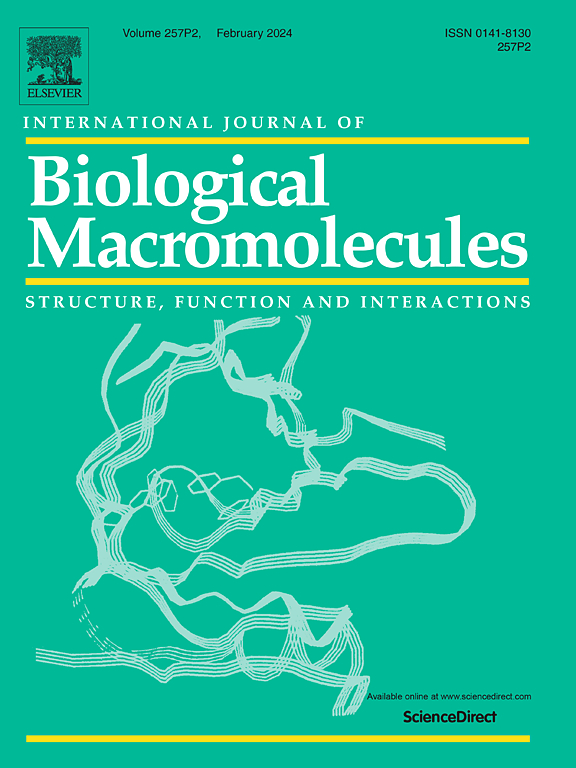Theabrownin/whey protein isolate complex coacervate strengthens C2C12 cell proliferation via modulation of energy metabolism and mitochondrial apoptosis
IF 7.7
1区 化学
Q1 BIOCHEMISTRY & MOLECULAR BIOLOGY
International Journal of Biological Macromolecules
Pub Date : 2024-11-17
DOI:10.1016/j.ijbiomac.2024.137686
引用次数: 0
Abstract
Theabrownin (TB)-whey protein isolate (WPI) complex coacervates (TW) were firstly prepared to investigate the regulatory effects on skeletal muscle. The binding of TB to WPI reached saturation with the strongest electrostatic interaction at the ratio of 10:1. The formation of TW was driven by electrostatic interactions with the aid of hydrogen bonding and hydrophobic interactions, and the digestion behavior of TW was investigated based on in vitro gastrointestinal and CaCO2 cell models. The regulatory effect of TW on muscle cells was investigated by C2C12 cell assay. Cell cycle analysis showed that TW promoted the transition of skeletal muscle cells from proliferative state to differentiated state. Immunofluorescence and gene expression revealed that TW positively regulated myogenic regulatory factors, contributing to myofiber formation. Moreover, TW activated the intracellular TCA cycling and oxidative phosphorylation, providing energy for skeletal muscle regeneration and repair. Mechanistically, TW inhibited the release of cytochrome C from mitochondria to cytoplasm through the Bcl-2/Cytochrome C/Cleaved-Caspase-3 pathway, exhibiting a protective effect on skeletal muscle cells. In the future, the molecular mechanism of TW enhancing skeletal muscle function should be validated through aging animal models and clinical trials and expand its therapeutic application for muscle health in functional food and dietary supplements.
棕褐色素/分离乳清蛋白复合物凝聚剂通过调节能量代谢和线粒体凋亡来增强 C2C12 细胞的增殖。
首先制备了茶褐素(TB)-分离乳清蛋白(WPI)复合凝聚物(TW),以研究其对骨骼肌的调节作用。TB 与 WPI 的结合达到饱和状态,在 10:1 的比例下静电作用最强。TW的形成是在静电作用的驱动下,借助氢键和疏水作用实现的,并基于体外胃肠道和 CaCO2 细胞模型研究了TW的消化行为。通过 C2C12 细胞实验研究了 TW 对肌肉细胞的调节作用。细胞周期分析表明,TW 能促进骨骼肌细胞从增殖状态向分化状态转变。免疫荧光和基因表达显示,TW 能正向调节肌生成调节因子,促进肌纤维的形成。此外,TW 还能激活细胞内 TCA 循环和氧化磷酸化,为骨骼肌再生和修复提供能量。从机理上讲,TW 可抑制细胞色素 C 通过 Bcl-2/Cytochrome C/Cleaved-Caspase-3 途径从线粒体释放到细胞质,对骨骼肌细胞具有保护作用。未来,应通过衰老动物模型和临床试验验证 TW 增强骨骼肌功能的分子机制,并在功能性食品和膳食补充剂中扩大其对肌肉健康的治疗应用。
本文章由计算机程序翻译,如有差异,请以英文原文为准。
求助全文
约1分钟内获得全文
求助全文
来源期刊
CiteScore
13.70
自引率
9.80%
发文量
2728
审稿时长
64 days
期刊介绍:
The International Journal of Biological Macromolecules is a well-established international journal dedicated to research on the chemical and biological aspects of natural macromolecules. Focusing on proteins, macromolecular carbohydrates, glycoproteins, proteoglycans, lignins, biological poly-acids, and nucleic acids, the journal presents the latest findings in molecular structure, properties, biological activities, interactions, modifications, and functional properties. Papers must offer new and novel insights, encompassing related model systems, structural conformational studies, theoretical developments, and analytical techniques. Each paper is required to primarily focus on at least one named biological macromolecule, reflected in the title, abstract, and text.

 求助内容:
求助内容: 应助结果提醒方式:
应助结果提醒方式:


